|
Springbrook is a refugium for relict reptiles of the most ancient lineages of tortoises, lizards and snakes considered to be basal amongst the world’s reptiles and which have evolved in East Gondwana. Reptiles exemplify major stages in the earth’s evolutionary history including ancestral and more recent major radiations in the Mid-Miocene associated with global cooling in the Cenozoic and the Plio/Pleistocene, the last Ice Ages. They were once one of the most successful evolutionary radiations and still represent one of the most diverse vertebrate groups alive on earth today. They thus contribute significantly to the Outstanding Universal Value of the Gondwana Rainforests of Australia World Heritage Area. Consideration of their critical habitat and landscape integrity requirements is important for the success of the restoration program associated with Springbrook Rescue. Reptiles evolved from early amphibians as far back as 220 Ma and, because they overcame a dependence on water compared with most amphibians, came to dominate every corner of the earth during the Age of the Dinosaurs. Most, however, became extinct at the end of the Mesozoic Era. Only four major groups are recognized today, three of which occur in Australia — turtles and tortoises (order Testudines), snakes and lizards (order Squamata), and crocodiles (order Crocodilia). The fourth group comprises an ancient group whose sole living representative is the lizard-like Tuatara of New Zealand. Only Testudines (turtles and tortoises) and Squamata (snakes and lizards) are represented at Springbrook. It has generally been accepted that chelid turtles, the diplodactyline geckos, the endemic family Pygopodidae (legless or flap-footed lizards) and agamid lizards have had a long history in Australia (Heatwole 1987). |
|
| TURTLES | |
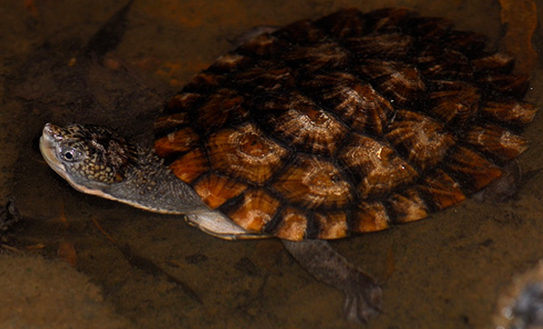 Wollumbinia latisternum Photo: Stewart Macdonald |
|
The earliest turtles date from 215 million years ago in the Triassic Period and as such are one of the oldest reptile groups, more ancient than lizards, snakes and crocodiles. There are 328 species of turtles (Testudines) present in the world today (The Reptile Database, 2012). There are 263 species of freshwater and terrestrial turtles but only 58 species of tortoises, and 7 sea turtles. Turtles and tortoises are now the most endangered group of vertebrate animals, with more than half of their 328 species threatened with extinction. One view is that modern turtles worldwide evolved from the Chelidae, a ‘primitive’ side-necked turtle group unique to Australia and South America. The Chelidae is known to comprise 52 species (The Reptile Database, November 2012). One member of the Chelidae is present at Springbrook — the Saw-shelled Turtle, endemic to Australia, found mainly in Queensland, with range extensions into New South Wales and the Northern Territory. It was renamed by Richard Wells in 2007, as Wollumbinia latisternum after Wollumbin (‘cloud catcher’), the Bundjalung people’s name for Mount Warning in the centre of the Tweed caldera. This is a significant area in the evolutionary history of this group of turtles. W. latisternum prefers sheltered, deeper waters under banks or under submerged logs and rocks in second or third order streams rather than major river courses. It is mainly diurnal but may bask during the day on exposed rocks and logs. Despite being territorial they retreat, sometimes in large numbers, to isolated water holes if their habitat becomes seasonally dry. It is carnivorous, consuming frogs, small fish, invertebrates and carrion. |
|
| SNAKES AND LIZARDS (squamates) | |
The earliest squamates (scaled reptiles) were the limbless dibamids and geckos which appeared more than 200 million years ago. These two groups together are sister to all other squamates (Wiens et al. 2012). The Order Squamata classically comprises three suborders: Snakes and lizards together (over 9,000 species in 61 families) make up nearly 95% of the world’s known species of modern reptiles (over 9,500 species). Of the world’s total of 5600 lizards, 723 species occur in Australia, 335 (46.3%) of these being found in Queensland. This is the second highest diversity in Australia after Western Australia (379 species). Generic diversity is highest in Queensland. There are seven families: the dragons, monitors, skinks, flap-footed lizards and three families of geckos (Wilson 2012). Springbrook, despite its small size, is home to 33 lizards or 10% of the total found in Queensland. These include:
|
|
| GECKOS | |
Geckos (infraorder Gekkota) are among the most species-rich and geographically widespread of all terrestrial vertebrate lineages with ~1450 described species in 118 genera and seven families comprising 25% of all described lizard species (Gamble et al. 2012). Carphodactylidae (29/29) Leaftail and knobtail geckos
|
|
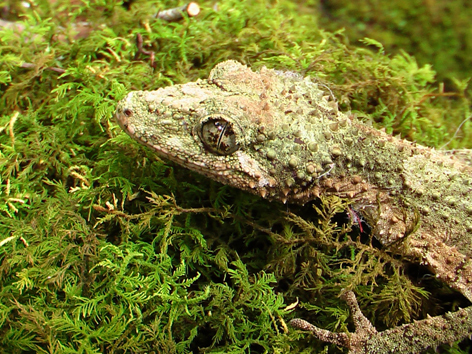 Saltuarius swaini Southern Leaf-tailed Gecko. A small genus and member of the East Gondwanan Carphodactylidae family that is basal to all lizards and snakes, now restricted to the moist upland rainforests of the McPherson Range. The species diverged from a common ancestor at least 50 Ma (Mulcahy et al. 2012). Photo: Ken O’Shea 30/9/2008 |
|
Pygopodidae(Legless Lizards, snake-lizards or flap-footed lizards) Diplodactylidae
Gehyra (36 species worldwide; 20 species in Australia) is rare among squamate radiations in spanning continents from south-east Asia to Australia and Polynesia. Gehyra is the only genus within the family that is the most species rich within Australia (Heinicke et al. 2011). If extinctions are taken into account, there is a strong possibility that the genus, like the Pygopodidae, is Gondwanan given the earliest Australian species date to at least 56 Ma, long before the final breakup of Gondwana and, in particular, collision with the Asian plate (Byrne et al. 2011). |
|
| DRAGONS | |
The Agamids belong to the suborder Iguania, a diverse group of lizards with ~1,600 named extant species or ~18% of all squamates (Uetz 2010). They inhabit a wide range of warm environments from deserts to tropical rainforests. Distinctively among lizards, their teeth are borne on the outer rim of the mouth (acrodont) compared with the inner side of the jaws (pleurodont). The Acrodonta are basal; the Pleurodonta are more recently evolved. The Agamidae family (Agamids) includes more than 300 species in Africa, Asia, Australia and a small number in Southern Europe. Six subfamilies are recognized |
|
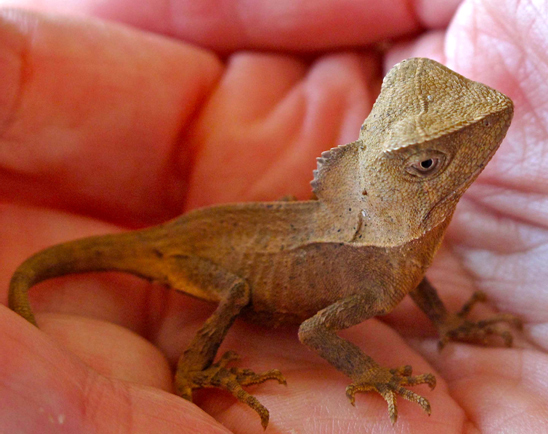 Lophosaurus spinipes: a baby Southern Angle-headed Dragon (Ken O’Shea 21/9/2009) |
|
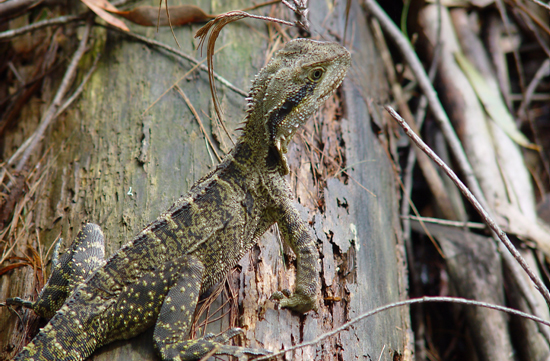 Young Water Dragon Physignathus lesueurii |
|
| MONITORS | |
The Varanidae family (monitors) is an ancient group of anguinomorph lizards with about 50-60 species in the sole genus Varanus. About half of all living species are found in Australia. At least ten subgenera of Varanus are recognized, two of which (Varanus and Odatria) contain the most species. Subgenus Varanus includes the large-bodied Australian and Indonesian taxa. Subgenus Odatria includes the small-bodied Australian endemic taxa. |
|
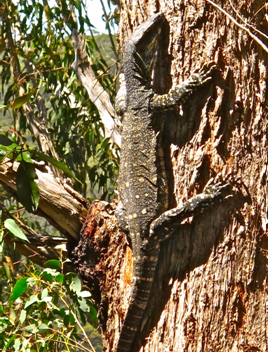 Varanus varius Lace Monitor on Ankida Photo: Aila Keto References Fry, B.G., Vidal, N., Normal, J.A., Vonk, F.J., Scheib, H., Ramjan, S.F.R., Kuruppu, S., Fung, K., Blair Hedges, S., Richardson, M.K., Hodgson, W.C., Ignjatovic, V., Summerhayes, R. and Kochva, E. (2006). Early evolution of the venom system in lizards and snakes. Nature 439, 584-588. Hutchinson, M.N. (1997). The first fossil pygopod (Squamata, Gekkota), and a review of mandibular variation in living species. Memoirs of the Queensland Museum 41, 355-366. |
|